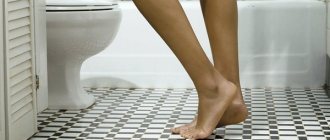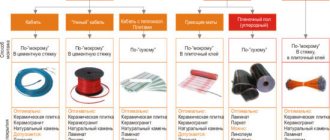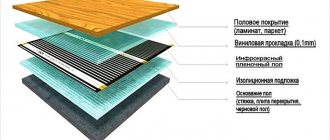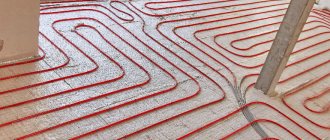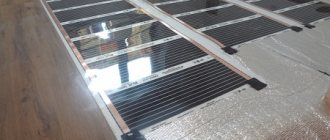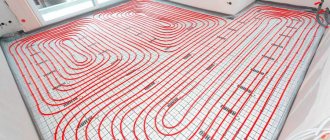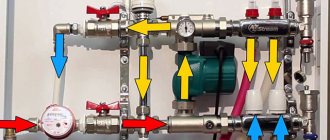The question of installing or altering heating arises before every owner of a house or apartment. Heated floors help increase heating efficiency and reduce utility costs. But can such a system fully replace radiator heating and will the costs of materials and installation be recouped? This question can only be answered if all the nuances and pitfalls are taken into account. In this article we will look at the issue of heating a house only with warm floors without radiators.
How is TP better than radiators?
During the construction phase of a new home, its owner has the opportunity to choose the appropriate heating option from a variety of available ones. But if there are already radiators in the room, then you need good reasons to refuse them. Floor heating has a number of advantages, which for many become a decisive factor when choosing:
- Efficiency . Unlike radiators, which primarily heat the space under the ceiling, heated floors transfer energy from the bottom up, uniformly heating the living part of the room at a height of up to 2-2.2 m.
- Saving . More efficient energy distribution allows reducing coolant costs by 20-30%. And while radiators will generally be cheaper to purchase and install, underfloor heating provides long-term savings that look into the future.
- Inertia . Depending on the type of radiator, this figure may differ, but the floors take longer to cool down after switching off.
- Comfort . The use of radiators requires a high coolant temperature (70 degrees). The average temperature of heated floors is 45° C, which is more comfortable and safer for the inhabitants of the house.
- Practicality . Radiator heating is characterized by a large volume of coolant, which is placed along the walls and under the windows, occupying part of the room. Underfloor heating is hidden from view, so it fits into any design and does not take up the usable area of the room.
We compare TP and batteries in this article and choose which is better.
Electric heated floor
Unlike a water system, in which it is impossible to organize a warm floor from central heating in an ordinary apartment, things are much better with an electric system.
It can be used both in a private house and in an apartment in a multi-storey building. The electric heating system is presented with the following heated floors:
- cable floor;
- film version;
- rod system.
The cable floor is presented in the form of wires, which are made of special alloys. Their unique ability is to convert electrical energy into thermal energy. Using a special thermostat, the user can regulate the amount of this very body and the heating in the room.
Electric heated floor
The main advantages of this option include a long operational period, which is several times longer than the life of a water heated floor, as well as economical energy consumption. In addition, it is very easy to do it yourself.
We recommend: Which underlay to use for heated floors?
The film version is a system consisting of several parts of a heating carbon fiber.
When electricity is applied, the film begins to emit infrared rays and anions, which are converted into thermal energy. A special advantage is that absolutely any floor covering can be laid on top of such a film.
The rod system is considered an innovative and very reliable option, which boasts not only a high level of safety, but also its environmental friendliness. Such a system is often called an intelligent electric heated floor.
The main element of such a system is carbon rods. The advantage of such a system is that it can be installed even in rooms that are constantly characterized by high levels of humidity, for example, in the bathroom.
Conditions for installation as the only heat source
Heated floors are considered a more economically advantageous heating system than radiator heating. But to make it effective, you will need to make careful calculations and take into account all the key parameters. In addition, the technical feasibility of implementing a particular type of heating should be determined in advance.
Among the important conditions for installing heated floors as basic heating are the following:
- The power of the heating elements should be sufficient to maintain the room temperature at 20-24 ° C even in the cold months.
- When calculating the heating of an apartment, heat loss through walls, doors and windows must be taken into account. For a private house, losses through the roof are also taken into account.
- The walls of the building not only transfer heat to the outside, but also let cold in, so when designing the system it is necessary to increase the heating of the room along the walls.
- Installing a water floor in an apartment building requires special permission. Even if it is available, installation will be difficult from a technical point of view.
- Installation of electric floors is possible for any type of room, but their connection requires properly functioning electrical wiring. In addition, heating a home using such a system increases energy consumption.
- All types of heated floors, except film ones, are laid under a concrete screed, which reduces the height of the room by 6-10 cm.
What to remember when using underfloor heating as the main heating system
- Where bedside tables, wardrobes or beds are installed, the warm floor will heat not the air in the room, but the furniture itself. When calculating, it is important to calculate not the total area, but the area that will be occupied by furniture;
- Heated floors have great inertia. The screed does take a long time to cool down, but it also takes a long time to heat up. Turning on the heating for several hours a day, wanting to maintain a stable and comfortable temperature inside the room every day, will definitely not work;
- A heated floor system, regardless of its type, cannot guarantee high efficiency in large areas. Its effectiveness decreases even more when it comes to large windows;
- Warm floors cannot be used to heat the vestibule. This room does not always end up in the area of the main walls. If the outer walls freeze, condensation will not form, but frost will appear very easily. You need to understand that it is simply impossible to exclude the flow of warm air from a heated room into a cold vestibule;
- May be uncomfortable in terms of temperature. The surface temperature of the heated floor is about 27-28 degrees. In this case, your feet will be as comfortable as possible. Taking into account the drop in temperature, in this case the room will be 1-2 degrees lower, and this is already a fairly high temperature for the human body, at which it may be uncomfortable. By lowering the temperature of the heated floor, your feet may become uncomfortable;
- It is impossible to organize a water heated floor from central heating.
We recommend: What is the pipe consumption for underfloor heating per m2?
Heating options without batteries
Today there are several types of heated floors, each of which has its own pros and cons. The feasibility of installing each type as the main heating depends on the parameters of the room and the planned heat source.
Water floor
To operate this type of heating, you need a boiler that heats the coolant and a pump that circulates water through the pipeline. Installation of a water floor is very complicated and requires laying several layers of material (thermal insulation, reinforcing mesh, concrete screed, finishing coating). Both independent and additional heating can be used for rooms of any size, however, for large houses it will be necessary to carry out complex calculations and install one or more collectors.
Cable floor
Cable-type electric heaters occupy part of the floor area (about 70%), they are placed in places free from furniture and heavy objects. It is usually used for independent heating of small rooms or as an additional one, since heating a large house with electricity is not economically profitable.
Infrared film floor
Suitable for small and medium-sized rooms and does not require laying a cement screed, so it is advisable to install IR film not only on the floor, but also on the walls and ceiling. This type of heating can be used as the main one, provided there is a stable power supply.
Rod electric floor
A deck made of interconnected carbon rods is laid under a concrete screed or tile and provides the most effective distribution of heat emitted in the infrared range. This type can be rationally used for heating individual rooms or small spaces.
Read more about choosing a heated floor and designing the system in our articles.
Which heated floor to choose?
Here a lot depends on various parameters and conditions. For example, the area of the room, as well as its location, is of particular importance.
If we are talking about a private house, then you can consider any type of heated floor, but it is still better to first evaluate the feasibility of each individual option in order to choose the most optimal one. As for the apartment, you will have to face special restrictions.
It is extremely important to understand the intended purpose of an underfloor heating system. If additional heating is required, then you can take a closer look at mats or film flooring.
If the warm floor will have to serve as the main heating, then it is logical to consider a water system or a high-power heating cable.
Product quality should also be a priority. Do not blindly trust advertising and buy systems from previously unknown manufacturers. It is best to trust certified products that, if used correctly, can last for years.
- Related Posts
- How to make a warm water floor in a private house with your own hands?
- How is Lavita underfloor heating installed?
- How to lay a heated floor without screed?
- How to install heated floors in a country house?
- How to lay heated flooring under laminate?
- How does automatic floor heating work?
Calculations
Each type of heated floors has its own calculation subtleties and design features, but the main task is to calculate the power of the heat source. This value determines the parameters of the heating system, as well as the type and quantity of materials required. The power is calculated taking into account such data as the area, shape and height of the heated room, the optimal temperature, and also depends on the design and operation of the heating system.
Calculating water heating parameters is a rather complex task that is best left to specialists. It includes the choice of the boiler, the diameter and length of the pipes, the choice of the number and types of control and distribution devices, as well as the calculation of hydro- and thermal insulation. A correctly performed calculation allows you to organize reliable and efficient operation of a warm water floor as the main heating system.
Determining the required power is the main task when designing electric floors, since the efficiency of the system and energy costs depend on its accuracy. The total power of the heating element will depend on operating conditions.
If an electric floor is used as independent heating (main heating), then the specific power should be in the range of 150-180 W/m2. If it is used as an additional heat source (comfort heating), then this value will be less (100-150 W/m2).
Read more about calculations of water and electrical transformer substations in our article.
Do you need radiators for backup?
Installing underfloor heating as the main heating system in a house is only effective if the walls, floor and roof have good thermal insulation. Otherwise, heat loss may be higher than the amount of energy generated by its heating elements. To prevent this, accurate calculations and installation of high-quality components are necessary, the costs of which will pay off in the future by reducing coolant costs.
Expert opinion
Sergey Permyakov
Heating systems engineer
Of all the types of heated floors, only water ones are capable of providing full heating of a medium or large country house instead of radiators if they are used as the main heating.
Other types can be effective for heating small spaces or individual rooms, but their operation will depend on the uninterrupted operation of the electrical network. That is why in cold regions it is more rational to use a combined heating system, including radiators and heated floors .
Which heated floor is better?
Today, there are two main types of underfloor heating – water and electric. The latter, in turn, is presented in three variations: rod, cable and film. Each has its own pros and cons.
The choice of a specific option directly depends on the conditions and possibility of installation. Assessing the main advantages of a heated floor, without taking into account its specific type, the following can be noted:
- well-being of the system. In simple words, a warm floor is able to maintain the temperature in a room as comfortable as possible for staying in it. Unlike traditional heating systems, there will be no place for local overheating or barely warm areas;
- aesthetics of heated floors. There are no visible elements of the heating system. There is no need to link it to the arrangement of furniture indoors. You can enjoy heated floors without radiators and get more free space to decorate your home;
- versatility. You can use any energy source (electric or water heated floor), any type of coolant (in the case of water heated floor) and any floor covering;
- human safety and health. A significant advantage of heated floors is the lack of dust circulation inside the room, which is a real salvation for people with allergies;
- efficiency. Optimal temperature distribution allows you to significantly reduce heating costs. Unlike traditional heating systems, a warm floor warms not the space above the ceiling, but the floor and the surface above it. Therefore, all rooms will have very comfortable conditions.
We recommend: Features of Korean heated floors
